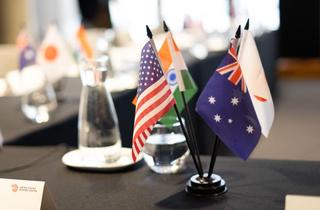Foreword
In December 2024, the United States Studies Centre hosted a Quad Leadership Track-1.5 dialogue in Sydney, in partnership with the Australian Department of Foreign Affairs and Trade (DFAT). This dialogue convened more than 40 academics, government officials and thought leaders from the four Quad nations to take stock of recent developments and their implications for the future of this strategic partnership.
The following is an overview of the key takeaways, including outstanding questions and suggestions, arising from the day’s dialogue. We sought to capture participants’ perspectives on the Quad’s evolution to a post-public goods agenda and outline the underpinning principles and continued strategic rationale for the grouping. We conclude with a discussion of emerging opportunities and challenges as the Quad seeks to consolidate and expand its security, technology, and partnerships workstreams.
It should be noted that this dialogue occurred less than two months before US Secretary of State Marco Rubio joined his Quad counterparts for a January 2025 meeting.
The dialogue convened more than 40 academics, government officials and thought leaders from the four Quad nations to take stock of recent developments and their implications for the future of this strategic partnership.
Summary
- Free from a bureaucratic structure, the Quad has evolved significantly from its initial standing as an ad-hoc cooperation mechanism for humanitarian aid in 2004 to become a leading minilateral in the Indo-Pacific. At the crux of the Quad’s strategic rationale has been harnessing the provision of public goods to nurture and promote a favourable regional order. The focus on a practical agenda has not only allowed Quad members to position themselves as credible and attractive benefactors to regional countries but also provided a pathway to operationalise alignment among the four members, despite certain differences in strategic priorities.
- Two decades following its inception, the Quad’s track record includes a range of initiatives about climate action, infrastructure, and critical and emerging technologies (CET) among other priority areas. In 2021, the elevation of the Quad to a leader-level summit enhanced its visibility and cemented the grouping as a key pillar of the Indo-Pacific architecture. While sceptics maintain that the Quad’s burgeoning scope lacks strategic direction and coherence, advocates argue that the grouping’s very value lies in the flexibility of its mandate — facilitating leader buy-in at the outset as well as enabling quick responses to regional public goods deficits and to countries’ emerging needs and priorities.
- Yet, concerns have undeniably emerged over the Quad’s capacity to deliver effectively and meaningfully, given the breadth of its initiatives. During the Track 1.5 dialogue, participants discussed the implications of two recurrent criticisms of the grouping, specifically pertaining to its delivery capacity and strategic communications. First, participants noted concerns over the Quad’s agenda being extended across too many portfolios. This has resulted in perceptions of the Quad’s announcements and efforts to be performative, undercutting the credibility of the grouping in the region as a contributor to stability and prosperity. Second, participants recognised the lack of targeted and coordinated messaging around the Quad creating an information vacuum that impedes the grouping’s engagements with external public and private stakeholders alike. This has fuelled the spread of disinformation, designating the grouping a mechanism to primarily contain China in Southeast Asia and the South Pacific. This has also hampered the Quad’s capacity to tap into public-private partnerships, undermining the confidence of investors in the Quad countries’ commitment to long-term commercial initiatives.
- Still, accounting for US$34.8 trillion in combined GDP and 44% of two-way merchandise trade across the Indo-Pacific region, participants noted the very grouping of the Quad presents real opportunity and strategic potential.1 In keeping with its origin as a provider of disaster relief and humanitarian aid in the wake of the 2004 Indian Ocean tsunami, the Quad’s support to regional countries to respond to non-traditional security (NTS) issues, specifically in the maritime domain, is both well-established and recognised. Participants noted its established track record and existing mechanisms to counter NTS create further prospects for strengthened intelligence cooperation and deepened operational synergy.
- Further, in leveraging the Quad’s combined technical, economic and industrial resources, CET has become a central focus of its activities. The grouping has sought to be at the forefront of delivery and innovation, and standard setting for CET in the Indo-Pacific region, resulting in various initiatives, such as the Cable Connectivity and Resilience Centre and the Open Radio Access Network (Open RAN). Likewise, attendees noted the potential for the Quad’s role as a convening mechanism, capitalising on its members’ respective access to regional institutions, such as Indian Ocean Rim Association (IORA) or the Pacific Islands Forum (PIF), as well as to private stakeholders and networks. In addition to fostering dialogue and collective outlooks to transnational challenges, this would provide new terrains for alignment and cooperation with actors in the region.
- Since its inception, few issues have spilled more ink around the Quad than its security agenda. Discussions during the dialogue echoed this lack of consensus, with differences expressed regarding the scope and rationale for the grouping’s security mandate and action. Despite widespread support for the Quad’s NTS agenda, suggestions to consider collective maritime security as a public good or to move towards explicit security and defence cooperation were met with concern. Proponents suggested that the four countries should regularise and capitalise on existing bilateral and trilateral military exercises to demonstrate a willingness and capacity to act in concert in the event of a crisis. However, other participants warned this would detract from the Quad’s public goods mandate and value proposition as a credible and attractive benefactor. Irrespective of these discussions, the arrival of the Trump administration may prompt a complete course reversal for the Quad. As doubts linger around his administration’s continued commitment to NTS issues, particularly climate change action, the 2025 Quad foreign ministers’ joint statement has irrefutably signalled a shift towards both an overt security rationale to prosecute the case for the Quad and a willingness to engage plainly in security and defence issues.
Introduction
The next Quad Leaders’ Summit will feature two new world leaders, if not three. Yet, 20 years after its establishment, the Quad has proven it can withstand both geopolitical uncertainty and electoral turnover. The Quad as it is known today — a strategic partnership between Australia, Japan, India and the United States — emerged from the ad-hoc coordination and provision of humanitarian assistance between the four countries following the 2004 Indian Ocean tsunami. This experience sketched out a model for the Quad, centred on flexible and practical cooperation. This model utilises the delivery of public goods in the Indo-Pacific as a point of entry to advance both the agency and the core strategic interests of its members. Revived in 2017 after a decade-long hiatus and elevated to a leader-level dialogue under the Biden administration in 2021, the Quad has now become a critical pillar of the regional architecture, at the forefront of its members’ efforts to advance a free and open Indo-Pacific. The grouping has since issued 13 joint communiqués and created a new working group structure as well as launched a plethora of initiatives, from the continued provision of disaster relief and advancing infrastructure cooperation to the delivery of public health campaigns. Meanwhile, the Quad’s increased maritime security focus, combined with bilateral and trilateral military and defence initiatives between its member countries, has signalled the strategic potential, and the implications, of an overt Quad security agenda.
Amid a shifting balance of power and the arrival of a US administration weary of multilateral inefficiencies, Quad members will need to marshal the minilateral platform, as well as their collective resources and expertise, to maintain its relevance and leadership as an effective bulwark in defence of a free and open Indo-Pacific region.
Much still needs to be done to right-size the Quad’s agenda. The breadth of its initiatives has at once established the partnership as a premier minilateral forum in the Indo-Pacific as well as raised concerns about the Quad stretching itself too thin across multiple lines of effort. Government officials, scholars and pundits alike are often unclear on whether a post-public goods agenda detracts from the partnership’s original value proposition or elevates it further. These debates around its future trajectory have transpired in the Quad’s branding and sceptics have been quick to point to the absence of deliberate and coherent strategic communications across all four countries. As the Quad seeks to simultaneously consolidate its gains and expand its scope, the grouping faces an inflection point. Amid a shifting balance of power and the arrival of a US administration weary of multilateral inefficiencies, Quad members will need to marshal the minilateral platform, as well as their collective resources and expertise, to maintain its relevance and leadership as an effective bulwark in defence of a free and open Indo-Pacific region.
The state of play: Progress and challenges
Since its inception, the Quad’s public goods mandate has provided terrain for strategic alignment between its member countries, addressing shared challenges while accommodating different geopolitical outlooks. Over the past decade in particular, efforts to develop tangible action items, from securing sea-lanes to providing humanitarian aid to strengthening economic resilience, have helped foster trust and habits of cooperation — at once stemming from and paving the way for deepened bilateral and trilateral engagement among the grouping’s membership. Despite refraining from overt references to China, the latter’s growing assertiveness in the region has undeniably allowed strategic interests between the Quad members to converge and breathed new life and direction into its initiatives. Both the Quad’s concerted communications on its fair, transparent and sustainable support, and its establishment of the working-group structure signalled a genuine attempt by the Quad to address key priority areas of partners and countries in the region and to provide credible alternative mechanisms to support countries in fulfilling their strategic, economic and development needs. Under this framework, tackling climate resilience, health security and critical infrastructure have all emerged as flagship priorities of the Quad as member countries seek to fill current public goods deficits across the Indo-Pacific.
Tackling climate resilience, health security and critical infrastructure have all emerged as flagship priorities of the Quad as member countries seek to fill current public goods deficits across the Indo-Pacific.
While this has facilitated opportunities for regional outreach, attendees noted that the Quad’s value proposition for countries in the region — and ultimately its ability to secure sustained buy-in — was contingent upon delivering on its promises in an effective and timely manner. While recognising the delivery of public goods as a powerful diplomatic tool to shape a favourable Indo-Pacific region, attendees raised concerns around the capacity of the Quad to execute and communicate its achievements across its multifaceted agenda, remarking on the geopolitical risks underpinning underperformance or expectation mismanagement. They further noted that a perceived absence of centralised or deliberate strategic communications has exacerbated doubts concerning the Quad’s mission and intended outcomes. In addition to inhibiting both the Quad’s agency and ambitions in the Indo-Pacific region, this ambiguity has created a vacuum for disinformation to spread in Southeast Asia and the South Pacific, hampering the Quad’s social licence among regional countries and partners. Similarly, private-sector representatives conveyed that a lack of clarity around the partnership’s agenda has precluded serious and sustained private investment in Quad capacity-building, infrastructure and technology workstreams, widely interpreted as a lack of the government commitment necessary to long-term commercial initiatives.
Sustaining the ‘case for the Quad’
The Quad’s continued viability and success is predicated on its ability to maintain its value proposition and core principles while evolving to reflect changing regional and global dynamics. Throughout its history, the grouping’s ‘public goods proposition’ has supported countries in the Indo-Pacific by addressing non-traditional security (NTS) risks. In the face of a plethora of new issue areas to address, the Quad must consolidate its existing track record in delivering public goods effectively as the foundation of its work while ensuring it is equipped for the challenges ahead.
Helpful in this context, as one senior attendee noted, is the re-characterisation of the Quad in public discussions as a caucus — a grouping that shares similar views or positions, and coordinates accordingly on responses — rather than an established alliance. Just as in a caucus, Quad members can hold disparate views on specific issues that reflect their national interests. Yet, even on points of difference, the grouping can provide an avenue for maintaining knowledge-sharing and communication channels between members.
Similarly, central to the Quad’s value proposition is its flexibility as a grouping — even if this comes with its challenges. Dialogue participants collectively acknowledged the Quad’s challenge in expanding to new issue areas, or even coordinating across existing lines of effort, without a more bureaucratic structure. One participant voiced support for the establishment of a secretariat, but this faced opposition from others who argued that the more formal institutionalisation of the Quad would impede its ability to adapt to new dynamics — a position shared by the majority of the room. Some participants also noted that the current flexibility aids the grouping’s longevity, allowing the Quad to more easily accommodate changing political and policy priorities at the leaders’ level. For example, this includes the ability for the partnership to address new areas of concern regarding influence and coercion in the region or to adjust the balance between the Quad’s public goods agenda and its regional security initiatives in line with broader geopolitical shifts.
This core foundation of flexibility — in both the positions of its members and the issue areas it tackles — reinforces the Quad’s position as an additional linkage that strengthens other, already resilient bilateral and trilateral ties. Member countries all share deep ties to one another that predate the Quad, and can draw on these, as well as other forums and platforms, in concert with Quad initiatives to promote and advance their joint agenda in ensuring a free and open Indo-Pacific. That being said, participants advocated for increasing institutional touchpoints between the four member countries, suggesting that greater government exchanges and secondments across government portfolios would facilitate integration and enable the systematisation of joint initiatives. Participants supported the planned expansion of ministerial discussions to include a Quad meeting of economic ministers and commerce secretaries to help foster common outlooks and approaches to supply chain resilience — and suggested other portfolios, such as those focused on science and innovation, could be valuable additions.
However, participants noted that the Quad should not allow its flexibility to lead to a passive or languid approach. As the likelihood for volatility in the region increases, it is critical that the Quad is proactive, conducting the necessary scenario- and forward-planning to ensure it has the necessary muscle memory to tackle future crises — aware of its capabilities, limitations and position within the broader patchwork of multilateral and bilateral relations that shape the Indo-Pacific. The ability for Quad members to embrace more formalised security cooperation in times of crisis is a critical asset that must be developed, honed and maintained.
The emergence of a post-public goods agenda
Technology and standards: An evolving approach
Critical and Emerging Technologies (CET) have become a centre of activity for the Quad and an exemplar for public-private collaboration, focused on technologies that are integral to the region. This includes the Quad Partnership for Cable Connectivity and Resilience established in 2023,2 which positions undersea cables as a regional infrastructure priority and is led by Australia through the Cable Connectivity and Resilience Centre, offering technical assistance, training, research and convening functions to boost engagement between Indo-Pacific governments and the private sector.3 Digital connectivity has been a focus, particularly in telecommunications, with the establishment of Open Radio Access Network (Open RAN) capabilities in collaboration with Palau and trials in the Philippines — as well as offering support for 5G equipment in Tuvalu.4 Other CET activities include the 2022 establishment of the Quad Technology Business and Investment Forum and dedicated horizon-scanning practices, including in synthetic biology,5 while activities across cyber and space have also been significant, including the development of the 2023 Joint Principles for Secure Software6 and efforts to tackle supply chain issues, such as in clean energy and semiconductors.7 Dialogue participants consistently praised these lines of effort, regarding CET as an example of the Quad’s success and an ongoing priority for the grouping.
The Quad has also initiated work on alignment and coordination relating to CET, including in standards setting. In particular, this includes the 2023 release of the Quad Principles on Critical and Emerging Technology Standards that affirms their shared commitment to industry-led, consensus-based approaches to international standards.8 Here, the Quad offers a valuable forum for discussion and coordination on CET-focused standard setting between like-minded countries outside of the more traditional Standards Development Organisations.
Given the combined economic and political weight of the four member countries, by coordinating their positions (when they align), the Quad can present a unified front when it comes to standards, providing companies operating in their markets with clear signals regarding expectations across the four economies. One example of this is the aforementioned Quad Joint Principles for Secure Software that point to the ambition for presenting aligned and consistent cybersecurity expectations and policies across the member countries. Echoing this, participants suggested the development of a ‘Quad’ risk assessment standard to support Indo-Pacific nations in better understanding and countering the uptake of high-risk vendors in their critical infrastructure systems. Moreover, even in areas where all four countries may not be in alignment, participants noted that the Quad still offers an important avenue for maintaining a dialogue for harmonising and setting norms, even if the outcomes are not always apparent.
However, while participants agreed on the importance of CET to the Quad, discussion was limited regarding specific future opportunities for public-private partnerships beyond those already underway, such as in semiconductor supply chains or subsea cables and digital connectivity. Instead, discussion focused mostly on what could be done to enhance existing initiatives or make use of existing models. This included suggestions to initiate discussions regarding information-sharing on the export controls of member countries to promote inter-Quad trade and collaboration in CET.
Fostering public-private and international collaboration
Fundamentally, the Quad’s success in implementing its sprawling agenda will continue to be defined by its ability to leverage relationships and capabilities — both internally between member nations and various working groups and externally between both nations and sectors — in pursuit of its stated goal of fostering a stable, free and open Indo-Pacific.9
Internally, participants noted the Quad grouping could be a platform to deconflict its members’ technical and development assistance to avoid duplication or over-burdening recipient countries. Further, while the working group structure does offer a useful analytical framework to discern the partnership’s initiatives, it also creates the risk of unnecessary silos. Participants called for the greater integration of Quad working groups, underscoring interdependencies and potential synergies, such as between climate and maritime security initiatives.
Beyond its own internal optimisation, the Quad’s external collaboration with both the private sector, and other nations and non-government entities offers opportunities to exponentially increase the grouping’s impact — enabling it to play an outsized role in addressing its core issue areas. More can be done to tap into the Quad’s convening power to bring together regional organisations, such as the Indian Ocean Rim Association (IORA), the Pacific Islands Forum (PIF), or the Association of Southeast Asian Nations (ASEAN), as well as to offer coordination support. In addition to strengthening the Quad’s standing as an inclusive and committed partner to advancing joint action to collective problems across the Indo-Pacific, this would lay the groundwork for further meaningful engagement with Indo-Pacific countries and for, where necessary, horizontal escalation with regional mechanisms and organisations.

For instance, recognising the Indo-Pacific’s enormous infrastructure investment needs, participants called for a concerted and urgent effort to map out and coordinate member countries’ individual infrastructure investments as well as to mobilise private- and public-sector capital to support infrastructure projects. In particular, they emphasised the role of infrastructure financing facilities as a security net, with recognition of existing efforts underway from Quad countries to extend over US$50 billion in infrastructure financing and assistance over the next five years.10 While the dialogue took place more than a month before the Trump administration significantly decreased US overseas development assistance budgets, dialogue participants highlighted the need for the Quad countries to continue their assistance efforts in the region, particularly in light of the revisionist actors in the region seeking to undermine democratic norms and sovereignty.
Beyond infrastructure, broader public-private engagement, collaboration and cohesion was a popular topic with attendees. Scholars and government officials concurred on the need to leverage Quad member countries’ research and industry networks as well as initiatives such as the Quad STEM Fellowships to build a stronger policy literature around the grouping and elevate its profile. This was echoed by calls to address the challenges of mobilising private capital to support Quad priorities — including the lack of long-term clarity provided to potential financiers. Alongside these proposals, participants also advocated for developing more long-term capacity-building mechanisms that invest in the shared strengths of the Quad countries and economies — empowering them to tackle future challenges, regardless of what form they may take. Ranging from incubators and venture capital programs to human resources development, such suggestions could bolster people-to-people ties and support supply chain diversification. However, participants stressed the need for patience in reaping the rewards of such efforts, as their value is likely to only become clear over the long term.
Some participants put forward ambitious proposals regarding the merits of the Quad acting as a forum for trade harmonisation, such as for negotiating tax incentives or being involved in regional free trade discussions, perhaps focused purely on CET, to promote greater public-private collaboration. However, these suggestions received mixed responses. It should be noted that a more understated but notable development in this direction already emerged from the 2024 Quad Leaders’ Summit, which promised a forthcoming set of Quad Principles for Research and Development Collaborations in Critical and Emerging Technologies.11 By focusing specifically on CET — an established area of focus and success for the Quad — and on early-stage research and development work, the grouping can address the gaps necessary to shift commercial assessments of specific opportunities by shouldering some risk, while promoting strategic priorities, such as the development of alternatives to high-risk vendors. Participants noted similar opportunities in areas like port infrastructure, where Quad member countries possess world-leading capabilities and there is strong regional demand.
Consolidating and expanding the Quad’s security agenda
The Quad’s support to regional countries to address NTS threats specifically in the maritime domain, from enhancing responses to countering illegal, unreported, and unregulated fishing (IUU) to disrupting transnational drug trafficking, is well-established. At the crux of the Quad’s efforts to enhance regional stability and maritime security, its NTS agenda provides continuity with the grouping’s foundational strategic logic and regional origin story, while eliciting few geostrategic sensitivities. The establishment of the Quad Partnership on Humanitarian Assistance and Disaster Relief in the Indo-Pacific in 2022, along with the subsequent release of associated guidelines, offers a compelling example.12 While no doubt seeking to strengthen capability and effectiveness, it formalised existing coordination and highlighted the Quad’s value proposition to regional countries as a provider of humanitarian assistance and disaster relief (HADR), observing the core principles of humanity, neutrality and impartiality.
At the crux of the Quad’s efforts to enhance regional stability and maritime security, its non-traditional security agenda provides continuity with the grouping’s foundational strategic logic and regional origin story, while eliciting few geostrategic sensitivities.
That same year, the Quad also launched its flagship initiative, the Indo-Pacific Partnership for Maritime Domain Awareness (IPMDA), providing access to satellite imagery to allow its members and partner countries across Southeast Asia, the Pacific Islands, and the Indian Ocean region to better detect and monitor activities in their respective maritime zones.13 While the remit of the IPMDA remains circumscribed, participants noted that increased information sharing among Quad members offers the necessary building blocks for intelligence collection, analysis and dissemination capabilities and marks a step forward towards developing a common operating picture. Similarly, US analysts observed that better leveraging existing and readily available resources provided by Quad countries may offer low-hanging fruit for enhanced operational synergy. For instance, in addition to strengthening Quad climate initiatives, utilising INDOPACOM’s Adaptation and Resilience Office could provide an opportunity for Quad and partner countries to engage in tangible scenario planning on climate resilience.
Participants recognised that collective efforts to address NTS were central to the Quad’s mandate, but overall, there was no consensus on the scope of the grouping’s security agenda going forward. The Quad has, to date, refrained from overt security and defence cooperation. However, member countries have increasingly collaborated, with Japan becoming a permanent member of Malabar exercises since 2015 (having first participated alongside the United States and India in 2007) and Australia regularising its participation since 2020.14 Though recognising the Quad's limited capacity to contribute to operational deterrence as a full set of four countries, security pundits noted these exercises had provided a format to hone interoperability and familiarise the four countries with one another’s operating procedures.
Still, the dialogue’s security experts asserted that contrasts in strategic priorities, or rather in the perception of threats among Quad members, have diluted the grouping’s security agenda. These participants assessed upholding collective maritime security through more overt defence and security cooperation to be a viable public good and, therefore, well within the remit of the Quad. Short of a formal commitment, further regularising and leveraging bilateral and trilateral military exercises would lay the practical foundations for future defence activities and bolster the Quad’s capacity to act in concert in the event of a crisis — demonstrating a collective willingness to absorb costs in pursuing their regional strategic objectives. However, responses to these suggestions were mixed. On the one hand, some participants acknowledged the Quad’s potential as a vehicle to strengthen collective deterrence and recognised upholding a favourable balance of power to be central to the Quad’s agenda, whether by hard or soft power means. On the other hand, some participants argued that this pertained to mission creep, and that could risk undermining the Quad’s engagement with Global South countries or fuelling narratives equating the Quad to an “Asian NATO.”
The way forward
The Quad’s future priorities will, in part, continue to be shaped by events in the region — it will likely remain a mechanism that primarily addresses public goods deficiencies in the Indo-Pacific. However, early developments under the Trump administration may signal a renewed intent for the Quad to take on a more overt and direct role as a grouping with an explicit focus on security and deterrence. It is noteworthy that all Quad foreign ministers attended President Trump’s 2025 inauguration, suggesting continued interest in the partnership against the backdrop of a change in US administration. Their joint statement, released on 22 January 2025, featured a prevailing security undertone that may signal the Quad’s greater — and perhaps more explicit — engagement with defence and security issues moving forward.15
The joint statement by the Quad foreign ministers, released on 22 January 2025, featured a prevailing security undertone that may signal the Quad’s greater — and perhaps more explicit — engagement with defence and security issues moving forward.
By consolidating and building on its record in infrastructure development and CET, which offer important security benefits, the Quad can become a grouping that offers not just public goods but delivers more ambitious regional security benefits, including through intelligence cooperation and coordination on maritime security. Alongside this shift, developing stronger coordination mechanisms with the private sector, harnessing its members’ bilateral and multilateral relationships, and engaging with non-government forums, will be essential to underwriting and multiplying the partnership’s efforts to drive the Quad agenda.
Throughout its more than two decades of existence, the Quad has proven to be a flexible and adaptable, if inconsistent, benefactor in the Indo-Pacific region. In the years to come, the grouping will need to draw on these traits and its leader-level prominence to deliver on its ever-growing mandate and act as the stabilising regional force it has endeavoured to be since its inception.









